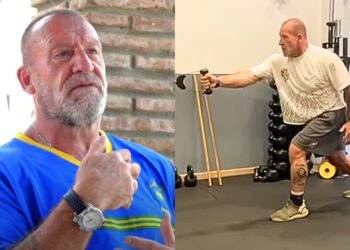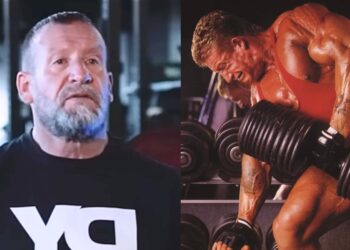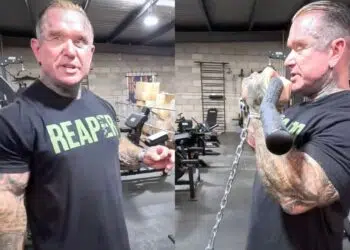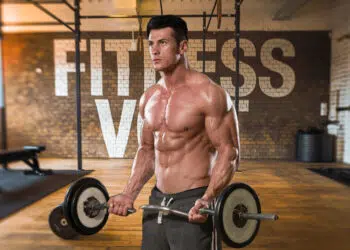When it comes to training, a lot of lifters pay very little attention to how they perform their reps. They load up the bar and then pump ‘em out with very little thought on how they are lifting or lowering their weights.
Such a closed-minded approach can work, especially if you’re genetically gifted or taking performance-enhancing drugs. But, less talented, non-enhanced lifters need to be more detail and technique orientated if they’re going to get good results from their workouts.
That means you can’t just lift weights – you also need to pay attention to how you lower them too.
In this article, we get positive with the negative part of strength training and reveal the advantages and benefits of eccentric and negative biceps curls.
The Anatomy of a Perfect Rep
The repetitions of most exercises are comprised of several different phases that overlap and roll into one. Paying attention to all these phases means that you’ll get more from your workout. Ignore any of these phases, and your workout could become less productive.
The phases of a repetition are:
Level Up Your Fitness: Join our 💪 strong community in Fitness Volt Newsletter. Get daily inspiration, expert-backed workouts, nutrition tips, the latest in strength sports, and the support you need to reach your goals. Subscribe for free!
1. Concentric
The concentric phase of an exercise is when your muscles shorten under tension. This is the part of the rep that most people tend to focus on. It’s also the weakest type of muscle contraction, which is why some exercisers use body English to help them lift the weight, e.g., kicking during leg extensions or swinging during biceps curls.
2. Transition (1)
Once you’ve finished lifting your weight and reached the mid-point of your rep, your muscles are under maximal tension. As such, it makes a lot of sense to pause briefly at this point.
This is what Master Blaster Joe Weider called the Peak Contraction Method. For example, after raising the dumbbells during curls, you could squeeze and contract your biceps as hard as possible before lowering the weights.
3. Eccentric
What does up must go down. In strength training, lowering a weight involves an eccentric or negative muscle contraction, which is when your muscles lengthen under tension. A lot of exercisers pay very little attention to the eccentric part of their reps and lower the weight too quickly.
That’s a shame because it’s the eccentric phase that’s responsible for much of the muscle-building effect of your workout.
You are stronger eccentrically than you are concentrically. In other words, you can lower more weight than you can lift. Therefore, it makes sense to lower weights with control to force your muscles to do more work. This extra work should translate to better results from your training.
Related: Best Eccentric Exercises To Supercharge Your Gains.
4. Transition (2)
Once your muscles have lengthened, it’s time to switch from an eccentric into another concentric contraction.
However, if you lower the weight too quickly, paying too little attention to the speed of the eccentric part of your rep, the weight will all but bounce back up because of something called the stretch-shortening reflex or SSR for short.
The more powerful the SSR is, the less work your muscles have to do, and the more ineffectual your repetition will be. So, if you emphasize the eccentric by lowering the weight more slowly, the SSR will be less active, and your workout will be more productive.
Some exercises begin with a concentric contraction, such as biceps curls and lat pulldowns. In contrast, others start with an eccentric contraction, e.g., squats and bench presses. But, regardless of which comes first, you should still pay attention to how you perform all four phases of your reps.
So, to perform a perfect muscle-building rep, you should:
- Lift the weight without the aid of momentum
- Pause briefly at the top of each rep and squeeze your muscles as hard as possible
- Lower the weight under control, taking longer than you did to lift it
- Avoid bouncing the weight up and out of the bottom of each rep
Because the eccentric phase is so important, you may find that emphasizing or even exaggerating it makes your workouts more productive. There are a couple of different ways to do this – eccentric and negative training.
Eccentric Biceps Curls
Eccentric training involves emphasizing the lowering part of each rep. You can apply this training method to most of the exercises in your workout. However, this article is all about the biceps, so we will focus on eccentric biceps curls.
How to do it:
- Load up a straight barbell or EZ bar with a little more weight than usual, e.g., an additional 10-20%. Remember, you are stronger eccentrically than you are concentrically, so you will be able to handle this extra load.
- Hold the bar with an underhand, narrow, medium, or wide grip, and stand with your arms straight, shoulders down and back, and core braced.
- Using your legs and lower back as necessary, curl the weight up to your shoulders.
- Next, apply the brakes and lower the bar smoothly, slowly, and under control, taking 3-5 seconds to complete your rep.
- Lift the weight again and repeat.
You can apply this method to many different biceps exercises, including:
Negative Biceps Curls
Negative biceps curls put even more emphasis on the lowering part of each rep. With negative curls, you do as little actual lifting as possible and put all your energy into lowering the weight. So, you’ll need a strong and willing training partner for this exercise.
Negative biceps curls are an advanced and very intense exercise, so only attempt it if you’ve spent a few weeks doing eccentric curls. Even then, because you’ll be lifting substantially heavier weights than usual, perform this exercise with care. Eccentric-only training usually produces severe post-exercise muscle soreness.
How to do it:
- Load your barbell or EZ bar with significantly more weight than you would typically use for curls, e.g., an additional 20-40%.
- Hold the bar with an underhand, narrow, medium, or wide grip, and stand with your arms straight, shoulders down and back, and core braced.
- With assistance from your partner, raise the weight to your shoulders. Your partner should do the majority of the lifting so you can save your energy for lowering.
- Lower the weight under control, taking at least 3-5 seconds to complete your rep.
- Again, with assistance from your partner, raise the weight up to your shoulders, and repeat.
- This exercise works best with low reps, i.e., 4-6 per set.
You can do negative-only training with several other biceps exercises. Either get a partner to lift the weight for you or if you are training alone, you can use a single dumbbell and your non-working free hand to help you lift the weight.
- Dumbbell curls
- Preacher curls
- Concentration curls
- Cable curls, etc.
Eccentric and Negative Biceps Curls – Wrapping Up
Eccentric and negative biceps curls can have a very positive effect on arm size and strength. Both of these training methods allow you to handle heavier than normal weights, creating more muscular tension and microtrauma and triggering rapid increases in muscle growth and performance.
But these training methods should not be taken lightly!
Working out with 20-40% more weight means more stress not only on your muscles but on your joints and ligaments too. Use these methods too often, and you could end up overtaxing your nervous system and overtraining.
Also, delayed onset muscle soreness is usually worse after eccentric and negative training, so expect some pain to follow your workout.
So, before you try either of these methods, spend a few weeks paying more attention to the eccentric part of your repetitions. Simply lower your weights a little slower than you lift them. This will prepare your body for the demands of eccentric and negative training.








